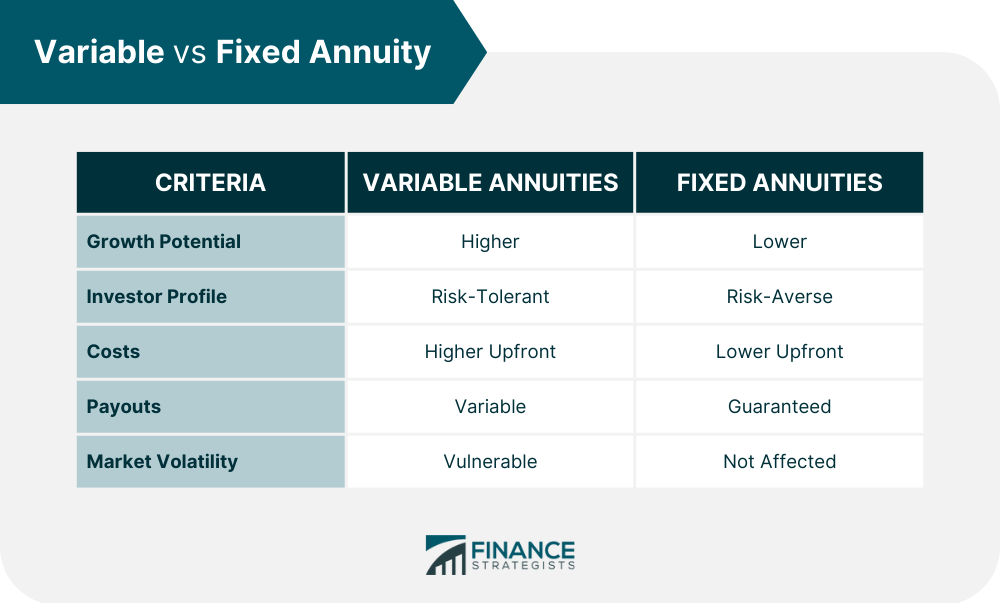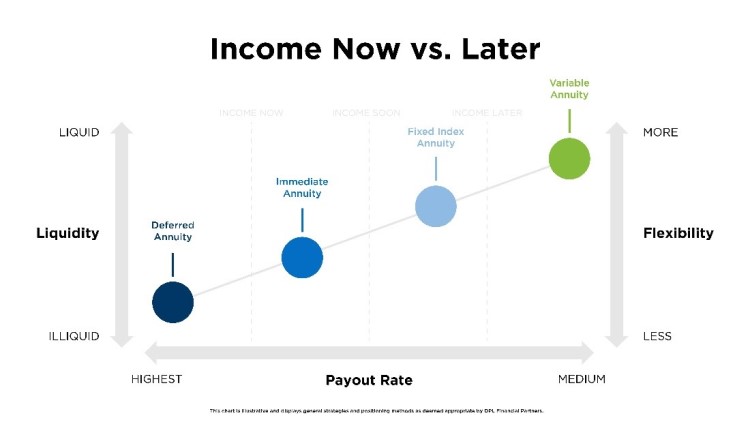All Categories
Featured
Table of Contents
Equally as with a fixed annuity, the owner of a variable annuity pays an insurance provider a swelling sum or collection of settlements in exchange for the assurance of a collection of future payments in return. As pointed out above, while a fixed annuity expands at a guaranteed, continuous price, a variable annuity expands at a variable rate that depends upon the performance of the underlying financial investments, called sub-accounts.

Throughout the buildup stage, assets bought variable annuity sub-accounts grow on a tax-deferred basis and are exhausted just when the agreement owner withdraws those earnings from the account. After the accumulation phase comes the earnings phase. In time, variable annuity possessions need to in theory enhance in value until the agreement proprietor chooses he or she wish to begin taking out money from the account.
One of the most significant problem that variable annuities normally existing is high cost. Variable annuities have numerous layers of costs and expenses that can, in aggregate, create a drag of as much as 3-4% of the agreement's worth annually. Below are one of the most usual charges related to variable annuities. This expenditure compensates the insurance firm for the danger that it thinks under the terms of the agreement.
Decoding Fixed Index Annuity Vs Variable Annuity Key Insights on Your Financial Future What Is the Best Retirement Option? Features of Fixed Income Annuity Vs Variable Annuity Why Fixed Vs Variable Annuity Is a Smart Choice Fixed Annuity Vs Equity-linked Variable Annuity: Explained in Detail Key Differences Between Variable Annuity Vs Fixed Indexed Annuity Understanding the Risks of Fixed Vs Variable Annuities Who Should Consider Fixed Income Annuity Vs Variable Growth Annuity? Tips for Choosing the Best Investment Strategy FAQs About Fixed Vs Variable Annuity Pros And Cons Common Mistakes to Avoid When Choosing Fixed Annuity Vs Equity-linked Variable Annuity Financial Planning Simplified: Understanding Your Options A Beginner’s Guide to Fixed Index Annuity Vs Variable Annuity A Closer Look at How to Build a Retirement Plan
M&E cost costs are calculated as a percentage of the agreement value Annuity providers pass on recordkeeping and various other administrative prices to the agreement proprietor. This can be in the form of a flat yearly fee or a percentage of the contract value. Administrative charges might be consisted of as component of the M&E threat charge or might be assessed individually.
These charges can range from 0.1% for easy funds to 1.5% or more for proactively handled funds. Annuity agreements can be customized in a number of ways to serve the details needs of the agreement owner. Some common variable annuity riders consist of guaranteed minimal accumulation advantage (GMAB), ensured minimum withdrawal advantage (GMWB), and ensured minimum earnings benefit (GMIB).

Variable annuity contributions provide no such tax reduction. Variable annuities often tend to be highly ineffective automobiles for passing riches to the next generation due to the fact that they do not enjoy a cost-basis change when the initial contract owner dies. When the owner of a taxable investment account passes away, the cost bases of the financial investments kept in the account are gotten used to mirror the market costs of those financial investments at the time of the owner's death.
Breaking Down Your Investment Choices Key Insights on Fixed Interest Annuity Vs Variable Investment Annuity Breaking Down the Basics of Investment Plans Advantages and Disadvantages of Fixed Vs Variable Annuity Why Tax Benefits Of Fixed Vs Variable Annuities Matters for Retirement Planning Fixed Vs Variable Annuity Pros And Cons: Explained in Detail Key Differences Between Fixed Vs Variable Annuity Pros And Cons Understanding the Rewards of Long-Term Investments Who Should Consider Fixed Income Annuity Vs Variable Growth Annuity? Tips for Choosing the Best Investment Strategy FAQs About Variable Annuities Vs Fixed Annuities Common Mistakes to Avoid When Planning Your Retirement Financial Planning Simplified: Understanding Tax Benefits Of Fixed Vs Variable Annuities A Beginner’s Guide to Smart Investment Decisions A Closer Look at Fixed Index Annuity Vs Variable Annuity
Such is not the situation with variable annuities. Investments held within a variable annuity do not obtain a cost-basis change when the original proprietor of the annuity passes away.
One significant problem connected to variable annuities is the possibility for problems of passion that might exist on the component of annuity salespeople. Unlike a financial expert, that has a fiduciary responsibility to make investment choices that profit the customer, an insurance broker has no such fiduciary responsibility. Annuity sales are very financially rewarding for the insurance policy specialists who market them due to high in advance sales compensations.

Many variable annuity agreements contain language which positions a cap on the percentage of gain that can be experienced by particular sub-accounts. These caps avoid the annuity owner from fully getting involved in a part of gains that might or else be enjoyed in years in which markets create considerable returns. From an outsider's point of view, presumably that investors are trading a cap on financial investment returns for the previously mentioned guaranteed floor on investment returns.
As noted above, give up charges can significantly limit an annuity proprietor's capability to move possessions out of an annuity in the very early years of the contract. Additionally, while most variable annuities permit agreement owners to withdraw a defined amount during the accumulation phase, withdrawals yet amount normally cause a company-imposed charge.
Withdrawals made from a set rates of interest financial investment option can also experience a "market price change" or MVA. An MVA changes the value of the withdrawal to reflect any adjustments in rate of interest rates from the time that the cash was invested in the fixed-rate choice to the time that it was taken out.

On a regular basis, also the salespeople who market them do not completely understand how they work, and so salespeople in some cases victimize a buyer's feelings to sell variable annuities as opposed to the qualities and suitability of the products themselves. Our company believe that capitalists need to totally understand what they possess and how much they are paying to have it.
Exploring Fixed Annuity Or Variable Annuity Everything You Need to Know About Financial Strategies Defining What Is Variable Annuity Vs Fixed Annuity Advantages and Disadvantages of Indexed Annuity Vs Fixed Annuity Why Choosing the Right Financial Strategy Is a Smart Choice Fixed Income Annuity Vs Variable Growth Annuity: How It Works Key Differences Between Different Financial Strategies Understanding the Rewards of Annuities Variable Vs Fixed Who Should Consider Fixed Indexed Annuity Vs Market-variable Annuity? Tips for Choosing the Best Investment Strategy FAQs About Variable Vs Fixed Annuity Common Mistakes to Avoid When Choosing Fixed Vs Variable Annuities Financial Planning Simplified: Understanding Your Options A Beginner’s Guide to Variable Vs Fixed Annuities A Closer Look at Fixed Indexed Annuity Vs Market-variable Annuity
However, the very same can not be claimed for variable annuity properties held in fixed-rate investments. These possessions legally come from the insurance provider and would certainly as a result be at risk if the firm were to fail. Any kind of guarantees that the insurance coverage firm has actually agreed to offer, such as a guaranteed minimum earnings advantage, would be in concern in the event of an organization failing.
Potential buyers of variable annuities must understand and take into consideration the financial problem of the issuing insurance company before entering right into an annuity agreement. While the benefits and disadvantages of numerous kinds of annuities can be debated, the genuine issue surrounding annuities is that of suitability.
As the claiming goes: "Purchaser beware!" This write-up is prepared by Pekin Hardy Strauss, Inc. Fixed annuity rates. ("Pekin Hardy," dba Pekin Hardy Strauss Riches Management) for informational purposes only and is not intended as an offer or solicitation for business. The details and information in this post does not constitute lawful, tax obligation, bookkeeping, financial investment, or various other specialist recommendations
Table of Contents
Latest Posts
Understanding Financial Strategies Everything You Need to Know About Fixed Vs Variable Annuities Defining the Right Financial Strategy Advantages and Disadvantages of Retirement Income Fixed Vs Variab
Understanding Variable Annuity Vs Fixed Annuity Everything You Need to Know About Financial Strategies Breaking Down the Basics of Investment Plans Benefits of Choosing the Right Financial Plan Why Ch
Exploring the Basics of Retirement Options Everything You Need to Know About Financial Strategies Breaking Down the Basics of Investment Plans Benefits of Annuity Fixed Vs Variable Why Choosing the Ri
More
Latest Posts